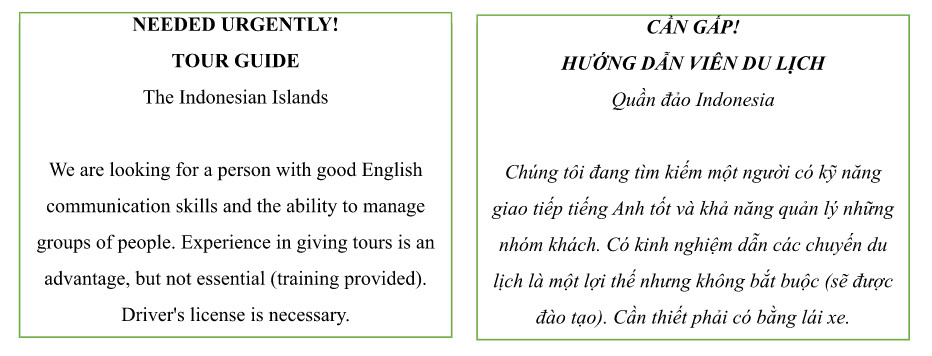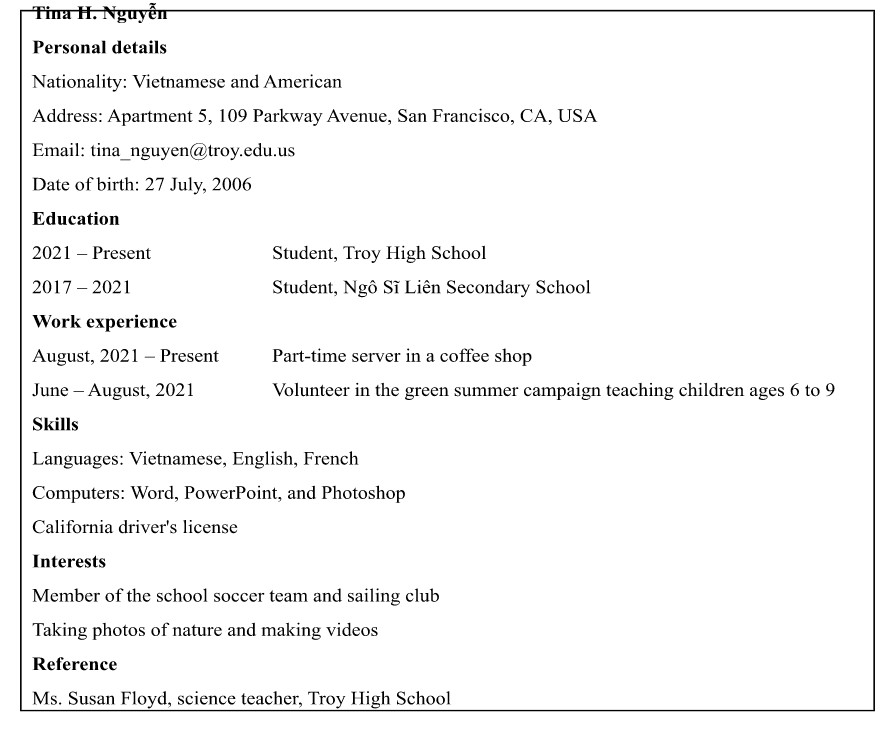Conversation (Optional)
(Hội thoại (Tự chọn))
F. Listen to the conversation. What was Pete doing when the fire drill started?
(Nghe đoạn hội thoại. Pete đang làm gì khi cuộc diễn tập chữa cháy bắt đầu?)
Alfredo: Hi, Pete. Last Friday, there was a fire drill at our school. Did you hear about that?
Pete: Oh, yes! I was preparing for the presentation with my friends when the alarm went off.
Alfredo: Oh, really? I didn’t know that. Was Alice with you at that time?
Pete: Yes, of course. While I was working with my group, she was talking to the teacher.
Alfredo: It seems everybody in the class was there except me.
Pete: Why? Where were you?
Alfredo: I was running in the school marathon on Fifth Avenue.
Pete: Oh, I remember. You represented our class in the marathon. Did you win?
Alfredo: Yes, I did. Look at my medal!
Pete: Congratulations! I'm so proud of you!
Tạm dịch:
Alfredo: Xin chào, Pete. Thứ sáu tuần trước có một cuộc diễn tập chữa cháy tại trường học của chúng mình. Bạn có nghe nói về điều đó không?
Pete: Ồ, có! Tớ đang chuẩn bị cho buổi thuyết trình với bạn bè thì chuông báo cháy vang lên.
Alfredo: Ồ, vậy à? Tớ không biết đấy. Alice có đi cùng bạn lúc đó không?
Pete: Có, tất nhiên. Trong khi tớ đang làm việc với nhóm của mình thì cô ấy nói chuyện với giáo viên.
Alfredo: Có vẻ như tất cả mọi người trong lớp đều ở đó ngoại trừ tớ.
Pete: Tại sao? Bạn đã ở đâu?
Alfredo: Tớ đang chạy trong cuộc thi marathon của trường ở Đại lộ số 5.
Pete: Ồ, tớ nhớ rồi. Bạn đã đại diện cho lớp chúng mình trong cuộc thi marathon. Bạn có thắng không?
Alfredo: Có chứ. Nhìn huy chương của tớ này!
Pete: Chúc mừng! Tớ rất tự hào về bạn!
- Pete was preparing for the presentation with his friends when the alarm went off.
(Pete đang chuẩn bị cho buổi thuyết trình với bạn bè thì chuông báo cháy vang lên.)

Các bài tập cùng chuyên đề
Listening (Nghe)
A. Read the job ad. What is the job? What skills do you need for the job?
(Đọc quảng cáo công việc. Công việc là gì? Bạn cần những kỹ năng gì cho công việc đó?)

Reading (Đọc hiểu)
A. In groups, try to answer the questions about “famous firsts”. Do you know any other famous firsts in history or in your country?
(Hoạt động theo nhóm, hãy cố gắng trả lời các câu hỏi về “những người nổi tiếng đầu tiên”. Bạn có biết bất kỳ người đầu tiên nổi tiếng khác trong lịch sử hoặc ở đất nước của bạn không?)
1. Who was the first person to win two Nobel Prizes in two different sciences?
a. Yuri Gagarin b. Neil Armstrong c. Marie Curie
2. Who was the first female musician to sell more than 300 million records?
a. Beyoncé b. Madonna c. Taylor Swift
3. Who was the first Vietnamese swimmer to break eight records at the 28th Southeast Asian (SEA) Games in Singapore?
a. Nguyễn Thị Ánh Viên b. Nguyễn Huy Hoàng c. Hoàng Quý Phước
B. Look at the photos and the title of the newsletter. Write five words you expect to read in the article. Compare in pairs.
(Nhìn vào các bức ảnh và tiêu đề của bản tin. Viết năm từ bạn mong đợi sẽ đọc được trong bài báo. So sánh theo cặp.)

C. Read the newsletter and answer the questions.
(Đọc bản tin và trả lời các câu hỏi.)
Vietnamese Women’s Achievements
Women have always played an important role in Viet Nam’s history. Some fight for their country, some inspire others, and some make positive changes to society.
Trưng Trắc and Trưng Nhị are examples of women who fought for their country’s freedom. Known in Vietnamese as “Hai Bà Trưng”, the Trưng sisters successfully led their people to fight against invaders in 40 A.D. After their victory, they ruled the country for three years. As the first female rulers, the Trưng sisters have become examples of the patriotic Vietnamese women. This is significant because Vietnamese women had little access to education and politics at the time.
Sương Nguyệt Anh is another example. As the daughter of the patriotic poet Nguyễn Đình Chiểu, she mastered literature from a very young age. She worked as a teacher before becoming the editor-in-chief of the Nữ Giới Chung, the first women’s newspaper in Sài Gòn, in 1918. Being the first female editor in Việt Nam, Nguyệt Anh made great contributions to the press, feminism, and poetry of the country.
A third example is Điềm Phùng Thị. She graduated from Hà Nội Medical University in 1946 and got a PhD in dentistry in France eight years later. When working as a dentist, she fell in love with sculpture and started practicing it. Later, she held several exhibitions around Europe with artworks about her homeland’s people. She became the first female Vietnamese member of the European Academy of Arts and Sciences in 1992 and her name was registered in the Larousse Dictionary of Painters.
achievement (n): something difficult that you have succeeded in doing
editor-in-chief (n): leader of a publication who is in charge of the content
1. Check your words in B. Are they in the newsletter?
(Kiểm tra các từ của bạn trong bài B. Chúng có trong bản tin không?)
2. Whose achievements are the most impressive? Why?
(Thành tích của ai là ấn tượng nhất? Tại sao?)
D. Read the newsletter. What do the following words refer to?
(Đọc bản tin. Những từ sau đây ám chỉ điều gì?)
1. they (paragraph 1) (họ (đoạn 1))
2. the country (paragraph 2) (đất nước (đoạn 2))
3. it (paragraph 3) (nó (đoạn 3))
E. Read the newsletter. Circle T for true and F for false.
(Đọc bản tin. Khoanh tròn vào chữ T cho câu đúng và F cho câu sai.)
| 1. There were no female rulers in Việt Nam before the year of 40 A.D. | T | F |
| 2. There are more educated Vietnamese women today than in the Trưng sisters’ time. | T | F |
| 3. The Nữ Giới Chung was the first newspaper in Việt Nam. | T | F |
| 4. Điềm Phùng Thị worked as a dentist before she became a sculptor. | T | F |
| 5. Điềm Phùng Thị’s contributions were internationally recognized. | T | F |
B. In groups, look at the advice for writing a resume. Discuss if each statement is true (T) or false (F) in your country and give reasons.
(Hoạt động theo nhóm, hãy xem những lời khuyên để viết sơ yếu lý lịch. Thảo luận xem mỗi câu là đúng (T) hay sai (F) ở đất nước của bạn và đưa ra lý do.)
| 1. Write about every school you have been to. | T | F |
| 2. List all your work experience (starting with the most recent job). | T | F |
| 3. Include a photo. | T | F |
| 4. Add information about your hobbies. | T | F |
| 5. Always write in full sentences. | T | F |
| 6. Give two references for people who know you well. | T | F |
| 7. Use a simple and clear computer font. | T | F |
| 8. Use lots of different colors. | T | F |
C. In pairs, discuss Tina’s resume. Does she follow your advice in B? What information is missing?
(Hoạt động theo cặp, thảo luận về lý lịch của Tina. Cô ấy có làm theo lời khuyên của bạn ở bài B không? Thông tin nào còn thiếu?)

Language Expansion: Personal Achievements
(Mở rộng ngôn ngữ: Thành tựu Cá nhân)
A. Read about Mac Dinh Chi. What did he achieve?
(Đọc về Mạc Đĩnh Chi. Ông ấy đã đạt được những gì?)
| Mac Dinh Chi was a poor boy from a small village in Việt Nam during the Trần Dynasty. When he was studying in his hometown, he could not afford an oil lamp to read books at night. Therefore, he put fireflies into eggshells and used their light to read the pages. With great dedication, he became a leading scholar in the village and later passed the palace examination as the highest-scoring graduate in 1304. |






